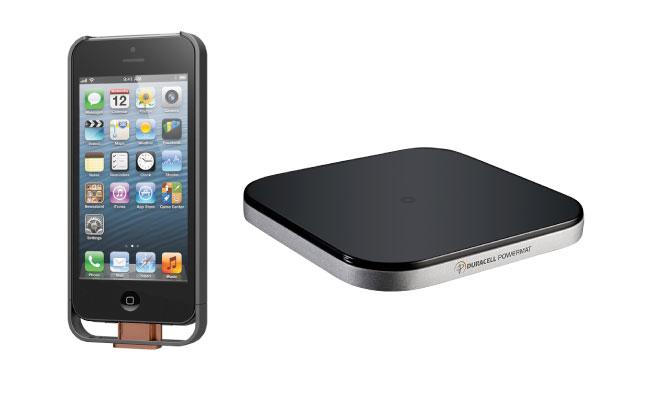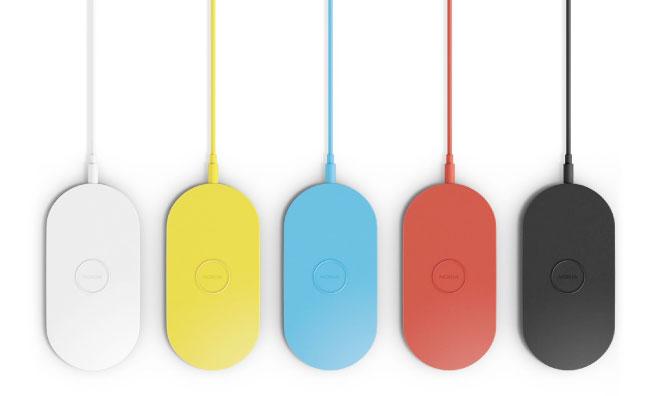Apple holds a bevy of patents on methods for broadcasting power to devices wirelessly, but the technology has yet to make its way into a shipping product from Cupertino. For anxious cord cutters, AppleInsider rounded up some of the most promising third-party solutions.
Duracell Powermat
The Duracell Powermat system is the most popular standalone implementation of Powermat's inductive charging technology, which is quickly gaining popularity. Heavily-trafficked places like Chicago's O'Hare airport and New York City's Madison Square Garden have added Powermat support, and General Motors will integrate the technology — Â first introduced in Chevrolet's Volt — Â into more members of its fleet in 2014.
Duracell's system consists of two parts: the AccessCase iPhone case with an inductive coil that sits just below the device's Lightning port and the Powermat itself, which comes in three sizes to accommodate charging one, two, or three devices at once. The cases, created by famed designer Yves Behar, add approximately 0.5 inches to the height of an iPhone 5 or 5s, though they weigh just 1.05 ounces, and a two-part design allows access to the Lightning port even with the case on.
After ensconcing your iPhone in the AccessCase, Duracell says that their system will charge "at speeds comparable to wired charging." All Powermat-based systems are interoperable with one another, so Duracell's case will also allow you to wirelessly top up your battery if you find yourself waiting for a delayed flight in the departures lounge at Chicago O'Hare or attending a Knicks game.
Duracell's AccessCase is available in black or white for $49.99 and a single-device Powermat is priced at $39.99. Duracell also sells external batteries and battery cases, similar to Mophie's popular Powerstation and Juicepack lines, that work with Powermat.
iQi Mobile
Powermat's main competition for wireless charging ubiquity is the Qi standard, backed by a diverse array of companies from semiconductor giant Qualcomm to mobile device makers like Sony and Nokia. Like Powermat, Qi stations are beginning to crop up at major airports, like New York's John F. Kennedy International, while national coffee chain The Coffee Bean and Tea Leaf is adding Qi charging hotspots in stores. Qi is also the technology used by Google and Samsung for the wireless charging functionality in their flagship handsets.
The iQi Mobile charger is a thin Qi receiver designed to be small enough to slip underneath a soft iPhone or iPod touch case. A flexible ribbon cable runs from the iQi to a Lightning connector, allowing the receiver to remain plugged in when folded behind the device.
At its thickest point — Â the Lightning connector — Â the iQi is just 1.4 millimeters thick, with the bulk of the receiver coming in at less than 1 millimeter. The iQi's backers say that users who already shroud their device in a soft case will note a barely perceptible difference.
One issue with the iQi is lack of access to the Lightning port once the device is installed —  though we haven't yet been able to test the iQi, unplugging it without removing the receiver from the case appears to be a daunting task that could potentially damage the iQi thanks to the ribbon cable's thin design.
The iQi is a Qi receiver only, meaning that a transceiver — the base station half of an inductive charging duo — must be purchased separately. Like Powermat, Qi devices are interoperable, so any Qi transceiver will work with the iQi.
The iQi team is funding manufacturing through a campaign on crowdfunding site Indiegogo which runs until Dec. 30. An iQi Mobile receiver and case package sits at the $25 reward level, and backers can add a transceiver to the set for $65. Larger packages with additional receivers and transceivers are also available.
Mix-and-match
Because the Wireless Power Consortium, the standards body in charge of certifying Qi devices, has done well in ensuring device interoperability, purchasing receivers and transceivers from different brands is a low-risk proposition for consumers who wish to do so for cost, location, or aesthetic reasons.
Nokia's DT-900 wireless charging plate is a well-reviewed Qi transceiver wrapped in an attractive package that matches the company's Lumia series of devices, though its good looks come at a premium — Â the device's $54.99 price tag is much more expensive than competing offerings from the likes of Lerway and ">RAVPower.
Qi-enabled cases hover around the $20 mark, with Evotouch and Choetech providing some of the most popular units.
Consumers who prefer the Powermat standard have essentially one choice — Â Duracell's products — Â for home use. Powermat's status as a commercial technology, as opposed to Qi's standing as an international standard, has restricted the third-party market.
 Shane Cole
Shane Cole









-m.jpg)






 Charles Martin
Charles Martin
 Malcolm Owen
Malcolm Owen
 William Gallagher
William Gallagher

 Christine McKee
Christine McKee
 Wesley Hilliard
Wesley Hilliard

 Andrew Orr
Andrew Orr







57 Comments
Inductive charging is a solution in search of a problem. There's not much convenience in wireless charging so long as it requires 1) a charging pad that takes up precious desktop/table space and 2) a power cord for the charging pad. If you must have something plugged into your computer and that something must take up space on your desk for the device to charge on - well you've just described a charging dock, with the only convenience being the ability to place the device on top of the charger instead of sliding it into a cradle. Not exactly a showstopper feature. For a wireless charging solution to truly make sense, it would have to be seamless and invisible. One possibility is that the technology becomes so ubiquitous and inexpensive that it can be built into a variety of furniture. A second possibility is that the technology advances to the point where a single power transmitter in the home can be designed to charge devices several feet away in a truly wirelessly fashion without the need for a charging pad or station (not sure if the physics support this.) At the moment, though, everyone's just jumping on a technology that sounds really cool without really providing any convenience for the user. I suspect this is a primary reason why Apple has yet to implement the feature in any of their products.
Inductive charging is a solution in search of a problem.
There's not much convenience in wireless charging so long as it requires 1) a charging pad that takes up precious desktop/table space and 2) a power cord for the charging pad. If you must have something plugged into your computer and that something must take up space on your desk for the device to charge on - well you've just described a charging dock, with the only convenience being the ability to place the device on top of the charger instead of sliding it into a cradle. Not exactly a showstopper feature.
For a wireless charging solution to truly make sense, it would have to be seamless and invisible. One possibility is that the technology becomes so ubiquitous and inexpensive that it can be built into a variety of furniture. A second possibility is that the technology advances to the point where a single power transmitter in the home can be designed to charge devices several feet away in a truly wirelessly fashion without the need for a charging pad or station (not sure if the physics support this.)
At the moment, though, everyone's just jumping on a technology that sounds really cool without really providing any convenience for the user. I suspect this is a primary reason why Apple has yet to implement the feature in any of their products.
I agree, although I would not go so far as what you suggested would work. Using AW4P, or Rezenze, which uses magnetic resonance, you would not have "several feet" of charging, but you would get a pad which can charge multiple devices at once, without the alignment needed for Qi charging, and also a bit more distance allowed than Qi (which would allow it to be built invisible into furniture).
Another main advantage of wireless charging is the fact the device could potentially be without any connectors. This will allow easier water-resistance (a feature I quite like from the Sony phones/tablets) and ofcourse will save some space on the internals (note, the charging will take up some more space, not sure what the net effect will be)
@freediverx I disagree.. having used it.. It's a godsend not having to plug and unplug, loose cables falling behind a desk or night stand. For me, since I use my phone as my alarm, not having to fumble in morning or at night with cables is really very nice! It wasn't searching for a problem, it solved a problem for me. You get wear and tear and it allows you to setup base stations at home, work, etc w/o having to think twice if the cable is in or worried about breaking the connector off (I've done twice now..) For me it simplifies my life. As for the whole furniture thing, thats just silly. wow..
I agree, although I would not go so far as what you suggested would work. Using AW4P, or Rezenze, which uses magnetic resonance, you would not have "several feet" of charging, but you would get a pad which can charge multiple devices at once, without the alignment needed for Qi charging, and also a bit more distance allowed than Qi (which would allow it to be built invisible into furniture).
Another main advantage of wireless charging is the fact the device could potentially be without any connectors. This will allow easier water-resistance (a feature I quite like from the Sony phones/tablets) and ofcourse will save some space on the internals (note, the charging will take up some more space, not sure what the net effect will be)
While devices that can charge without the need for power connectors sounds great - and precisely the sort of feature Apple would drool over - the magic would fail the moment you need to charge the device in your car, at the office or anywhere else away from home. You will still need power connectors until/unless some standardized wireless charging technology becomes ubiquitous.
Now if Apple could come up with a wireless travel charger that wasn't too much bigger than today's chargers, that would be amazing.
Inductive charging...
"Prior to the release of the iPhone 5, rumors circulated that Apple would bring wireless charging to bear in that handset, but Apple marketing exec Phil Schiller said after the unveiling that the perceived convenience of such systems was questionable, since charging mats would still need to be plugged into an outlet.
In September, an Apple patent application emerged demonstrating a "realistic and practical approach to wireless power, providing over-the-air electricity to low-power devices within a distance of one meter.
As for the whole furniture thing, thats just silly. wow..
Yeah I guess you're right. Why would anyone ever design furniture with built-in power? No one would want or use such a silly feature.